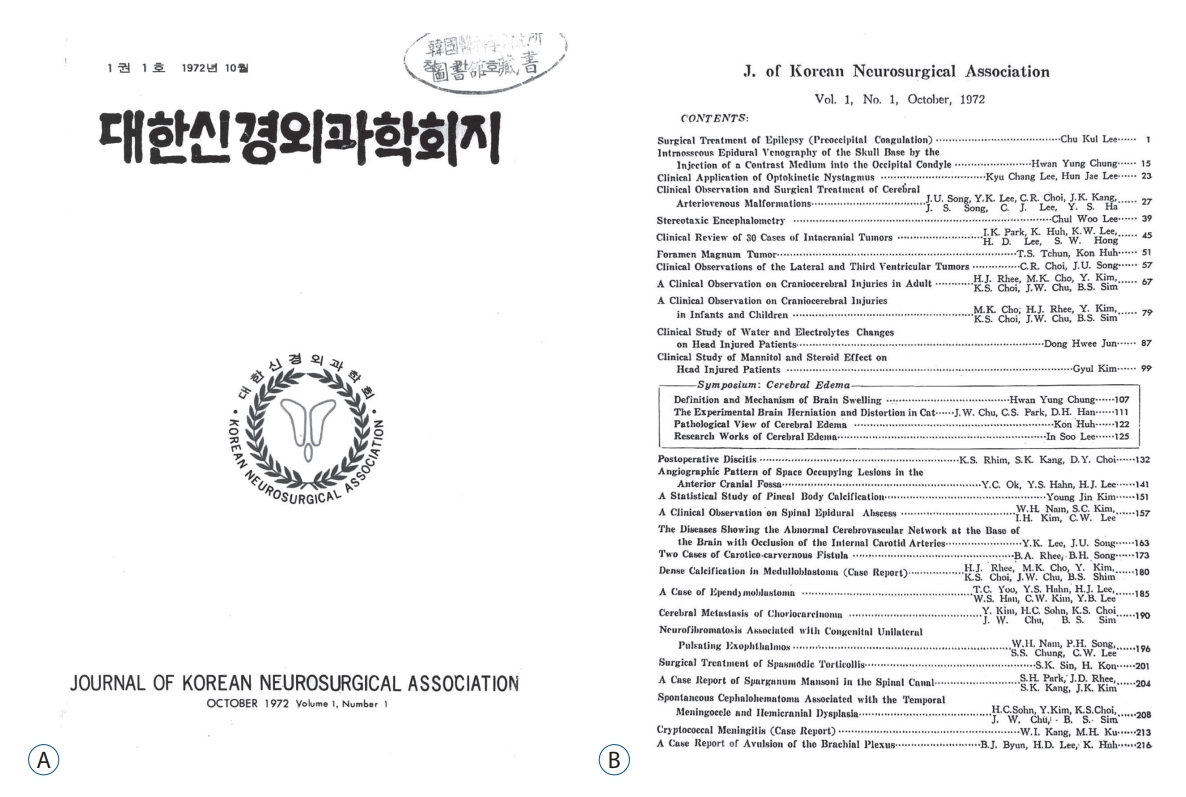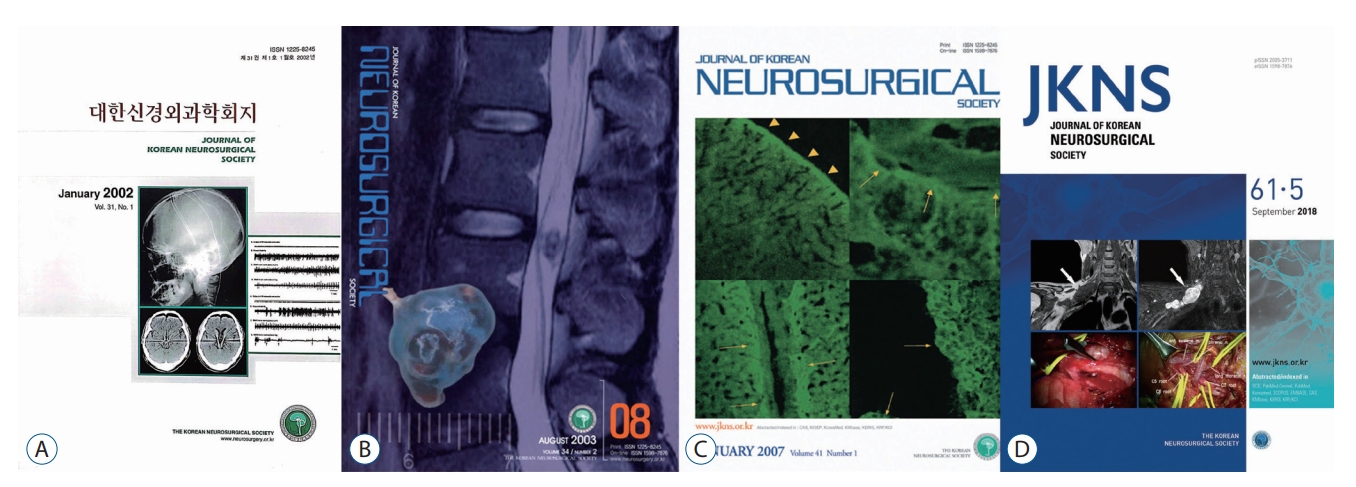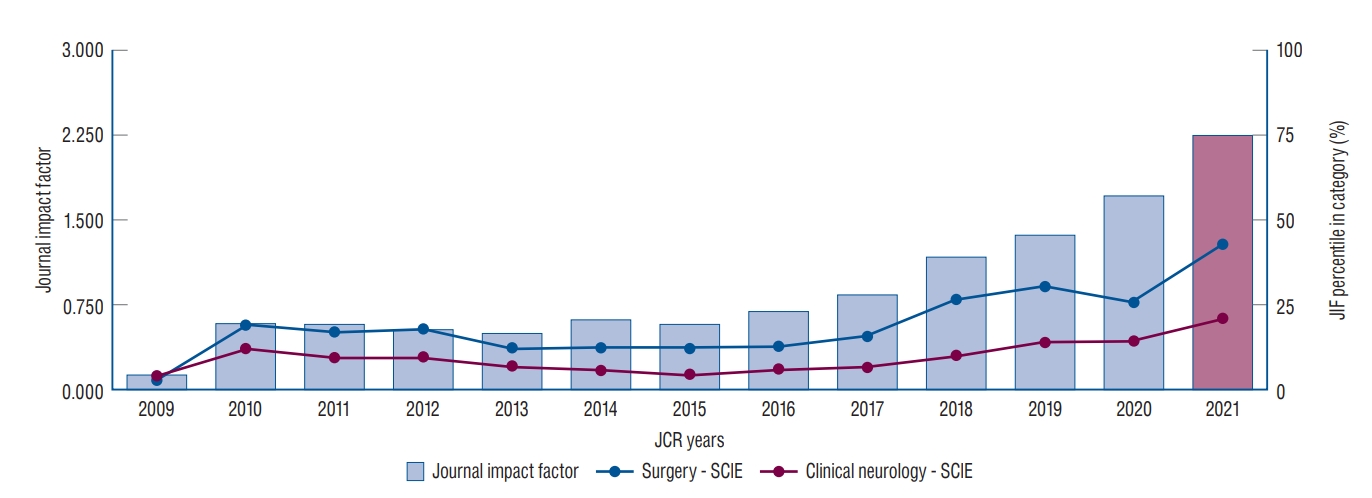Chung, Yang, and Park: Half-Centennial History of Journal of Korean Neurosurgical Society : Midway from Domestic Journal to International Journal with Good Influence in Global Neurosurgery
Abstract
October 2022 marks the 50th anniversary of the founding of Journal of Korean Neurosurgical Society (JKNS). Staring as official journal of Korean Neurosurgical Society (KNS) in 1972, JKNS is a journal that is listed in the science citation index (SCI) and its impact factor has been steadily rising in recent years. The past history of JKNS was reviewed with a focus on important milestone, and the direction of future development is suggested.
Key Words: Journal of Korean Neurosurgical Society · Korea · Neurosurgery · Journal impact factor.
INTRODUCTION
It is estimated that there are about 30000 medical journals in the world. Probably the number will increase with acceleration. In this circumstance of overflowing number of medical journals, the struggle for a higher reputation is growing fiercer.
October 2022 marks the 50th anniversary of the founding of Journal of Korean Neurosurgical Society (JKNS). Many organizations commemorate the 50th anniversary as a significant occasion. Looking back on the footsteps of the past half century will serve as an opportunity to explore the future development direction of JKNS.
FOUNDING OF JKNS
Although the Korean Neurosurgical Society (KNS) was established in March 1961, it took 11 years before the first issue of JKNS was released. The need for establishment of KNS’s own academic journal was raised at the board of directors in 1970. It is said that there was a dispute over the necessity of an independent academic journal, considering relatively small size of number of members of KNS at that time. Finally, it was decided to launch JKNS. The first issue (Korean title “daehansingyeong-oegwahaghoeji”) was published in October 1972 with 219 pages and 31 articles [ 4]. There were 14 review article, 11 original articles and six case reports in the first issue of JKNS. According to the table of contents, almost every fields of neurosurgery were covered in the first issue of JKNS : tumor, cerebrovascular disease, spine, functional and stereotactic, neurotrauma, pediatric and basic research ( Fig. 1). Prof. In-Soo Lee was the first editor-in-chief of JKNS, who was succeeded by Jeong Hyeon Woo in 1973. The Editor-in-Chief of JKNS was an important board member of KNS, who then took over for a 1 or 2-year term thereafter ( Supplementary Table 1 and Supplementary Fig. 1).
PROGRESS OF JKNS AS OFFICIAL JOURNAL OF KNS
The journal was published twice a year from 1973 to 1981, and quarterly from 1982 to 1987. During the transition period from 1988 to 1992, six to nine issues were published every year, and monthly from 1993. The annual number of articles published increased in accordance with the increase in number of issues per year and reached about 200 articles in the year of 1996. During the 30 years since it was founded in 1972, there were about 4000 articles were published ( Supplementary Table 2). Among them were 2000 clinical articles, 500 laboratory researches, 52 review articles, in addition to 1580 case reports. With respect to subspecialty, articles on cerebrovascular diseases were about 950, followed by spinal diseases 905, brain tumor 896 and trauma 350. Index was made on October 1994, covering from the first issue, and ISSN was given from the national library [ 4]. As an official journal of KNS, it has been firmly established as the primary domestic journal for publication by KNS members for the first 30 years and has become a model for launching KNS branch journals. The next 20 years were the process of JKNS’s development as an international journal.
PIVOTAL PERIOD OF TRANSITION AND PREPARATION FOR MAKING GREAT STRIDE : 2001-2006
Although JKNS has been performing its role as an official journal of KNS well, there were several problems that needed to be settled down in order to develop into a better status around 2000. First of all, JKNS was often published behind the schedule, which is one of the basic requirements of academic journals. The administrative work was done by a parttime worker, and the process for editorial work, reception of submitted papers, assignment of reviewers, recording of results of reviews were managed by handwritten list. However, the most serious problem was that the articles published in JKNS were not searchable in real time. Periodically published index was not up to date and the search function provided by the journal home page was very limited, which seriously impeding the citation chance of useful information published in JKNS.
KNS also aware of the need for groundbreaking action for the development of JKNS. In order to secure continuity of editorial work, KNS decided to elect a person to focus on for the development of JKNS along with his tenure along with unwavering administrative and financial support. Prof. Dong Gyu Kim was the first Editor-in-Chief with security of tenure, and the tradition has been kept to this day [ 7]. An editorial secretory with, experience of related field was hired as a full-time employee, and computer-based data base was built for managing editorial work. Revisions of various regulations and document forms in accordance with changing trends of research and publications ethics were also done. In order to ensure rapid dispatch of the pending issues, weekly editorial meeting was held with participation of Editor-in-Chief, editorial secretary and two associate administrators of the editorial board. In addition, the editorial committee held a bimonthly for final confirmation of manuscripts to be published and for decision on major issues requiring consensus of editorial board [ 7]. The journal has also been improved in appearance. The long-standing monotonous over design, was changed from its first issue of 2002 to an illustration for noticeable articles of that issue. The cover design has since been changed a more up-to-date style ( Fig. 2). Detailed review in the final editing process reduced page volume with enhanced readability. Another important effort for progress of JKNS was hosting educational programs for authors, reviewers and editor in order to provide useful information for manuscript preparation, peer review and editorial processing. Since the first editorial workshop on March 13th, 2002, a number of workshops were held for KNS members. These workshops, including useful and up-to-date lectures by experts in relevant fields, were very helpful for improving the various steps of publication of JKNS : submission, review and editorial decision and policy [ 7]. One of JKNS’s biggest concerns, the problem of effective retrieval of published papers, was partially resolved as it was listed in KoreaMed, which can search Korean medical journals in PubMed format. It was an important milestone in being able to systemically search JKNS articles along with other domestic medical journals, providing feasible search [ 4, 7].
ENLISTMENT IN SCIENCE CITATION INDEX (SCI) AND PROGRESSIVE DEVELOPMENT IN SCIENTIFIC QUALITY
The longing for JKNS to be listed in the international index was when JKNS was listed in PubMed in 2007, SCOPUS in 2008, and finally in SCI in the same year. It cannot be denied that the enlistment in SCI was affected by the strengthening of the status of Korean medicine in general, but it is to be emphasized that it was possible because of such as improving the editorial system and meeting international standards of medical journals. This development was greatly aided by the Korean Association of Medical Journal Editors (KAMJE), which helped in reorganizing the system in order to be enlisted in international data bases, such as PubMed, SCOUS and SCI, as in other Korean medical journals [ 8]. After being registered in the international index, several measures were taken to reorganize the system of JKNS for the next level of development. Ethics in medical research and publication has become increasingly important issue in recent years and has become an important concern not only in medical field but also in society in general. As the first effort to meet this social demand, the similarity check system to filter out plagiarism was adopted in December 2014 [ 6]. All submitted articles were subjected to the similarity check system. In addition, ethical guideline for article submission was amended in terms of duplication, data falsification, and authorship issues according to international ethical standard. The journal homepage and the submission system were reorganized in 2016 and in 2017, respectively, to make it easier for author to submit their article and for readers to search published papers. Through this series of measures, the current operating system of JKNS has been established. However, no matter how well-organized the journal system was established, the scientific quality of the journal cannot be improved unless the authors would like to submit their influential research achievements. Publishing articles of high academic interests from international readers has been a key element utilized by most medical journals in order the enhance their reputation [ 5]. Considering that most researchers want to publish their research results in more influential journals, it was difficult for JKNS, which had a low impact factor before 2017, to receive manuscripts with high probability of citation. To make researchers interested in the JKNS was the very first step to enhance scientific interests. To achieve this purpose, the editorial office started to send out table of contents of new issues and a list of top cited articles to members of KNS and past-authors at the time of publication of every new issue [ 1]. When an article is cited, a notification is sent to the author so that authors can know whether their article is being cited. The authors of a highly cited articles were selected and celebrated by posting the photo on the cover of JKNS. In addition, the reviewers who reviewed the submitted manuscripts faithfully were also selected and their photos were posted on the cover of JKNS. Early online publication had also started. Early exposure of accepted articles online enhanced an opportunity for papers to be cited as quickly as possible. Furthermore, the editorial board members officially asked internationally renowned researchers to publish their recent research through JKNS. They submitted a number of review papers on various fields of neurosurgery, which has enabled JKNS to publish articles of interest to readers and of high probability of citation. It was found that considerable proportion of articles (53%) got no citation on reviewing the journal citation report [ 2]. It was concluded that it was meaningless to publish papers that are not cited in terms of information distribution. It was decided that manuscripts that did not have sufficient scientific value were to be rejected for publication through stricter review. In line with the decrease in the number of published papers, the number of annual publications has also been reduced to six a year from 2016. Thanks to the result of unremitting efforts for progress of JKNS, the journal impact factor (JIF) began to increase from 2018 and now in trend of continuous increase till now ( Fig. 3) [ 3]. In addition to increase in numerical value of JIF, there is prominent improvement of rank of journals in the field of surgery and clinical neurology. This means that the influence of JKNS is growing continuously ( Table 1) [ 3]. One of the desirable points of JKNS is its low self-citation rate. Only 6.8% of citations come from JKNS itself, which means the articles published in JKNS draw global attention and include up-to-date information.
THE FUTURE OF JKNS, PURSUING VALUES BEYOND HIGH IF JOURNAL
JKNS has achieved a lot of success so far. It is time to reflect on the past 50 years and think about what values JKNS should pursue in the future. It goes without saying that we should continue to pay attention to improve the influential power of the journal. However, rather than just focusing on the JIF, it is necessary to think about which goals a journal should pursue to gain a better reputation. We hope that JKNS will become an international channel for domestic researchers as well as researchers from all over the world to publish good results related to neurosurgery while maintaining the standards of research and publication ethics, and to present new standards of patient care. Considering that KNS has supported the development of branch societies, JKNS should also actively support and cooperate with journals published by branch societies to achieve mutual development.
The achievements that JKNS has accomplished so far would not be possible without the support of KNS and KNS members. The editorial board of JKNS would like express deep gratitude to all who has devoted themselves for the progress of JKNS. No one knows what kind of status JKNS will hold in the future. We hope that the development of JKNS over the past 50 years will be a midpoint of the development that will be achieved in the next 50 years.
“Perhaps we will be forgiven if we claim we are about midway to our objective!”
- Chester W. Nimitz (Fleet Admiral, US Navy), after the Battle of Midway, CINCPAC (Commander-in-Chief, Pacific Ocean Areas) Communiqué No. 3, (6 June 1942)
Supplementary materials
Supplementary Table 2
Number of issues and articles published in Journal of Korean Neurosurgical Society
Supplementary Fig. 1
Twenty-two editors of Journal of Korean Neurosurgical Society for 50 years. From the left of the first row, In-Soo Lee, Jeong Hyeon Woo, Hwan Yung Chung, Jeong Hwa Chu, Bo Sung Sim, and Hun Jae Lee. The second row, Kwang She Rhim, Kyu Chang Lee, Ki Dhan Lee, Duk- Young Choi, Sang Sup Chung, and Won Leem. The third row, Dae Hee Han, Kwang Myung Kim, Young Soo Kim, Hoon Kap Lee, Dong Gyu Kim and Kyeong-Seok Lee. The third row, Jung Yul Park, Chang Taek Moon, Bum-Tae Kim and Hee-Jin Yang, Figure creased by combining archived photographs in Korean Neurosurgical Society.
Fig. 1.
The first issue of Journal of Korean Neurosurgical Society, which was published in October 1972. The cover (A) contains logo of the Korean Neurosurgical Society at the center. The table of contents (B) shows the categories, titles and authors of articles published in this issue. 
Fig. 2.
Change of cover of Journal of Korean Neurosurgical Society. From January 2002 (Vol. 31, No. 1), figure of interesting article was placed on the cover for the first time (A). The cover style from January 2003 (Vol. 34, No. 1; B), from January 2007 (Vol. 41, No. 1; C); from January 2017 (Vol. 60, No. 1; D). Although there have been changes in format of the cover, the tradition of placing figures of articles of that issue on the cover has been maintained till now. 
Fig. 3.
Increase of impact factor of Journal of Korean Neurosurgical Society. It is notable that there is a continuous rise since 2017. JIF : journal impact factor, JCR : journal citation reports. 
Table 1.
change of JIF rank of Journal of Korean Neurosurgical Society
|
Year |
Clinical neurology
|
Surgery
|
|
JIF rank |
Quartile |
JIF percentile |
JIF rank |
Quartile |
JIF percentile |
|
2021 |
167/212 |
Q4 |
21.46 |
121/211 |
Q3 |
42.89 |
|
2020 |
177/208 |
Q4 |
15.14 |
156/211 |
Q3 |
26.30 |
|
2019 |
174/204 |
Q4 |
14.95 |
146/210 |
Q3 |
30.71 |
|
2018 |
178/199 |
Q4 |
10.80 |
140/203 |
Q3 |
26.85 |
|
2017 |
183/197 |
Q4 |
7.36 |
168/200 |
Q3 |
16.25 |
References
4. Hwang SN, Kim DG : Journal of korean neurosurgical society for 30 years. J Korean Neurosurg Soc 32 : 371-375, 2002
|
|



















